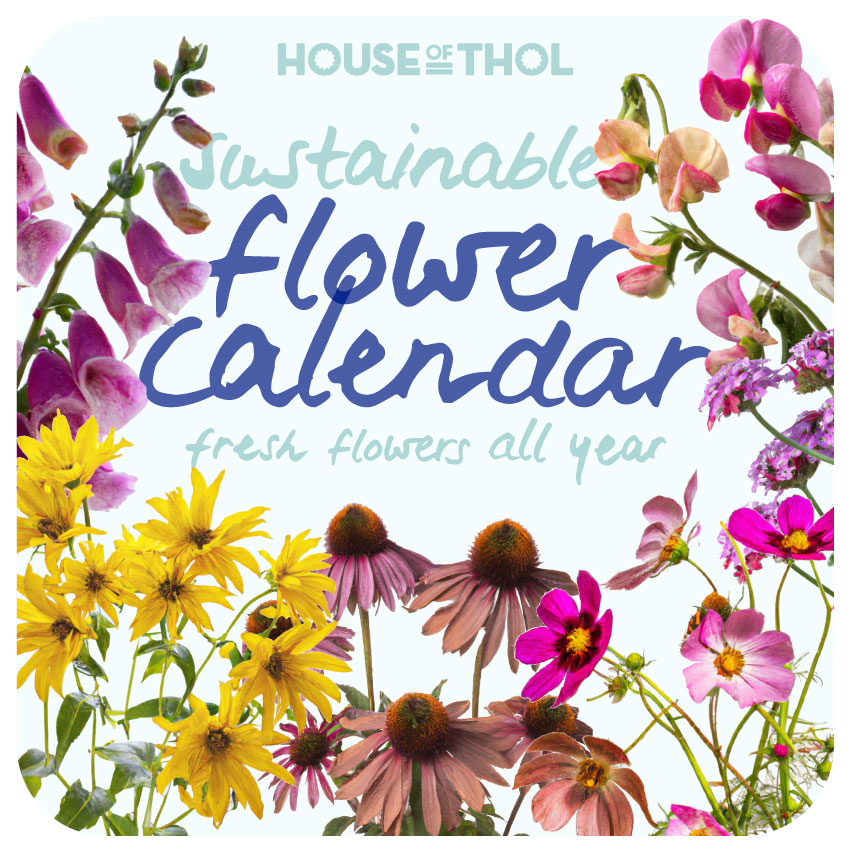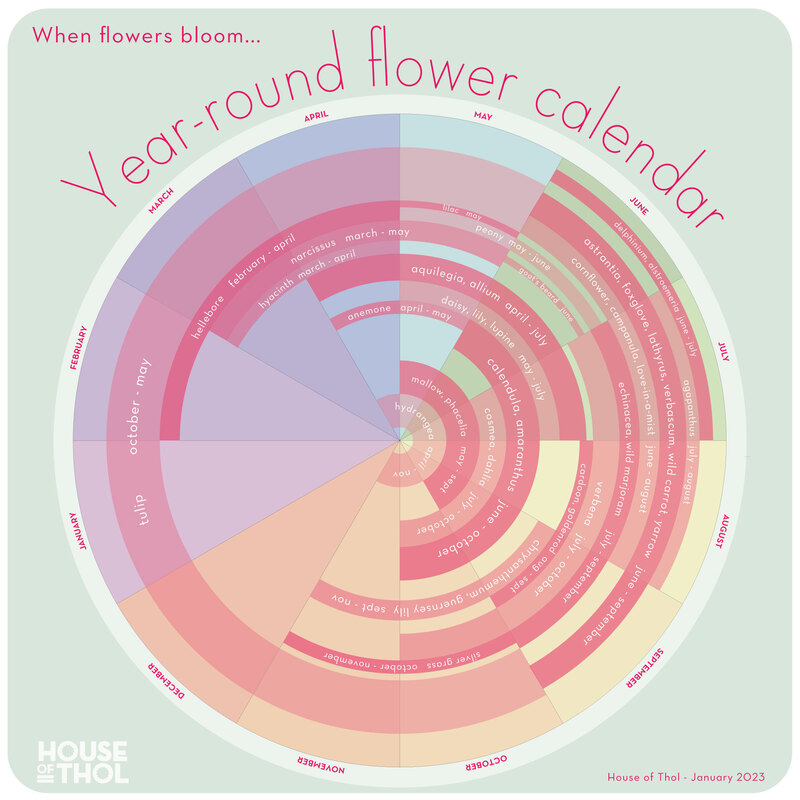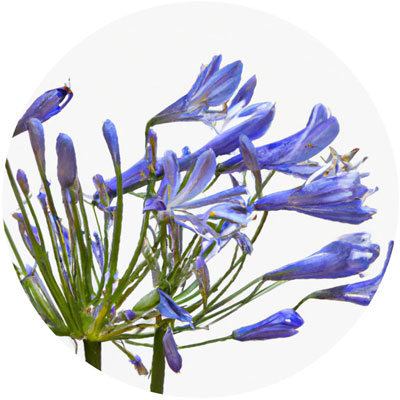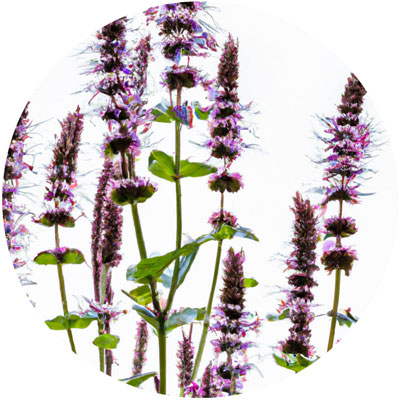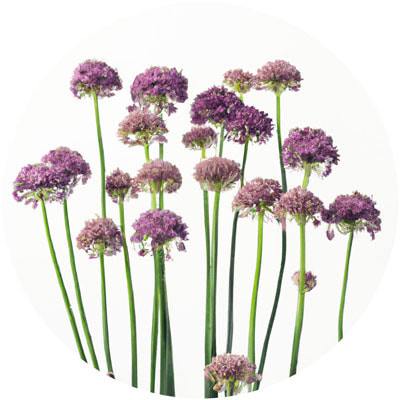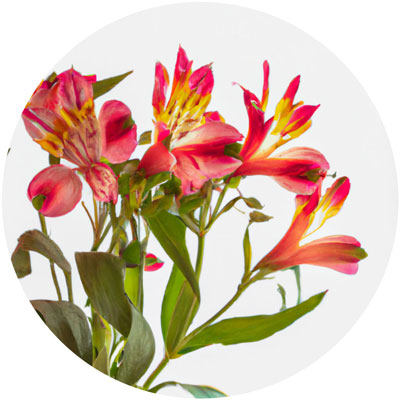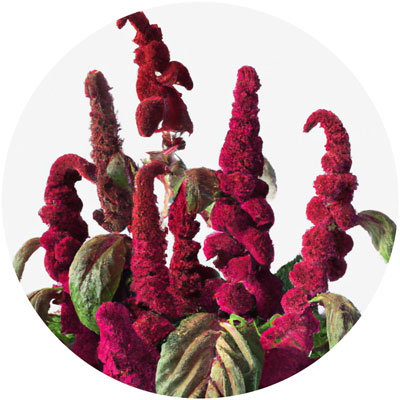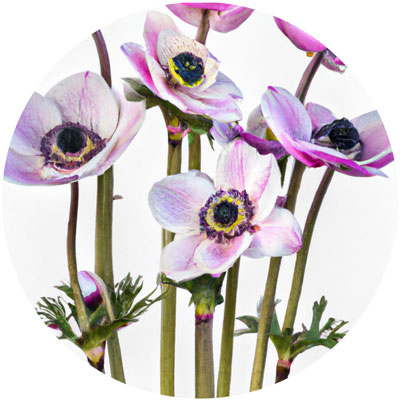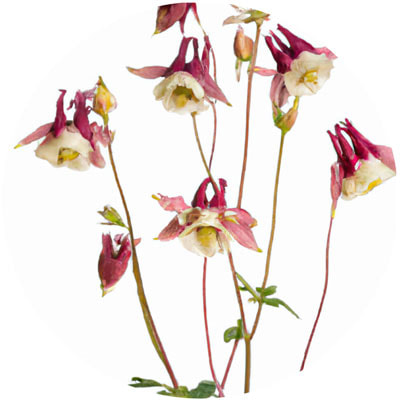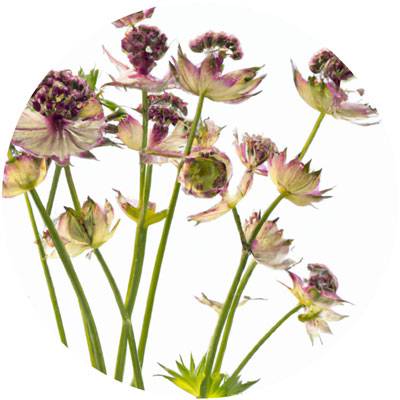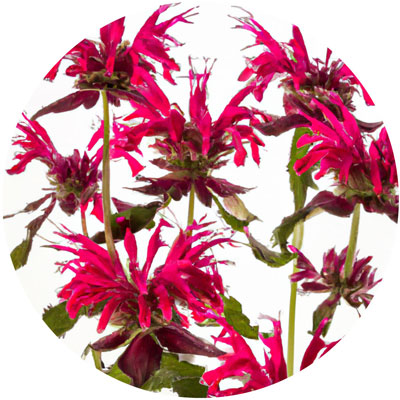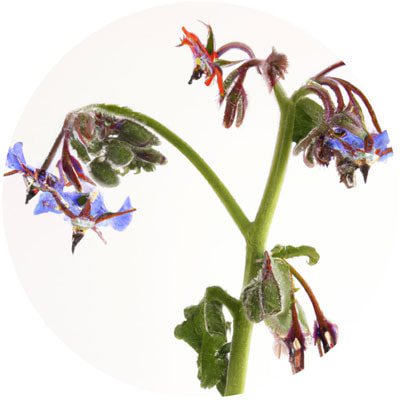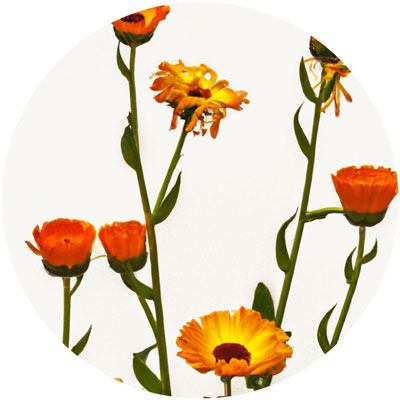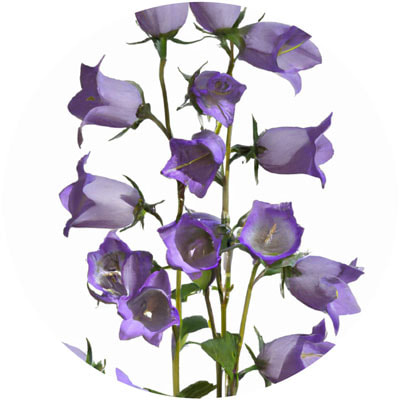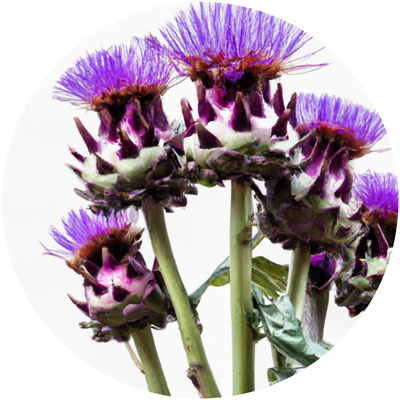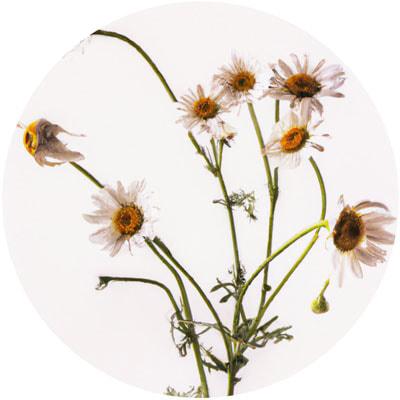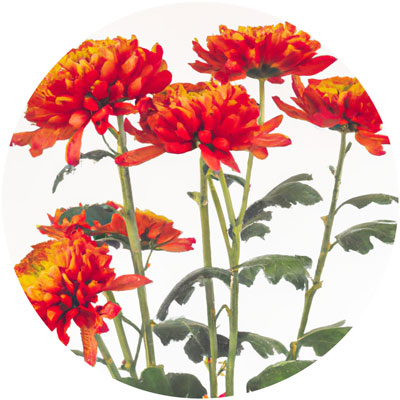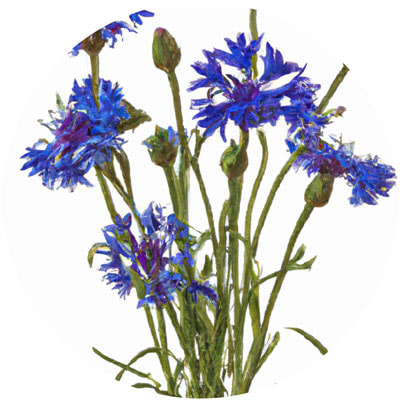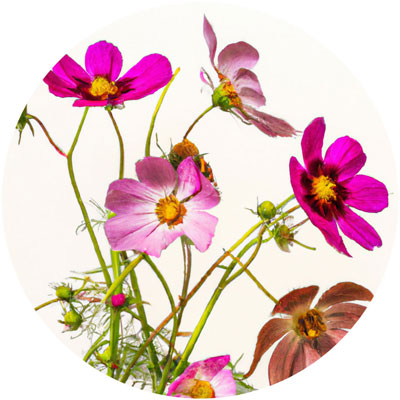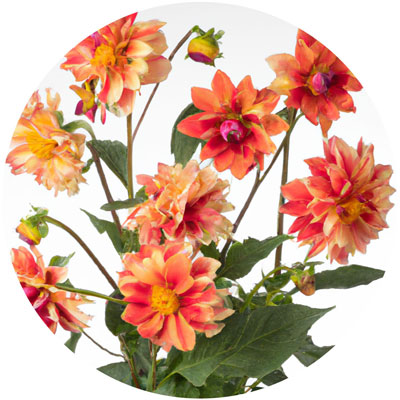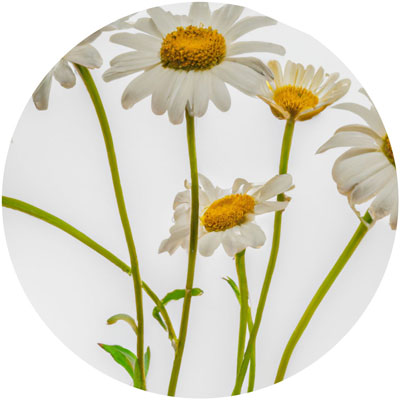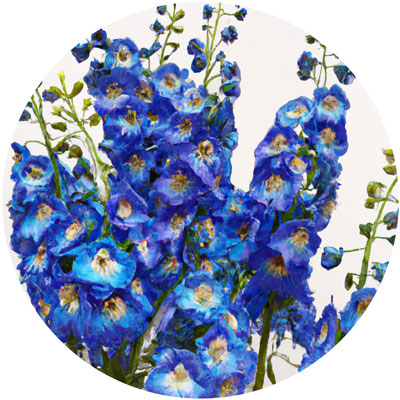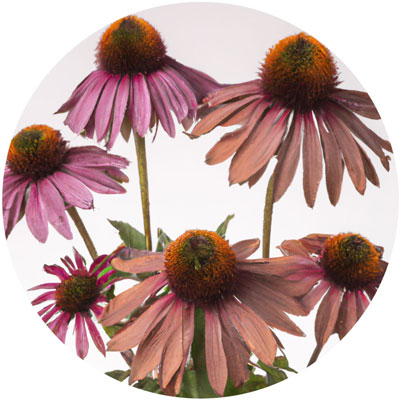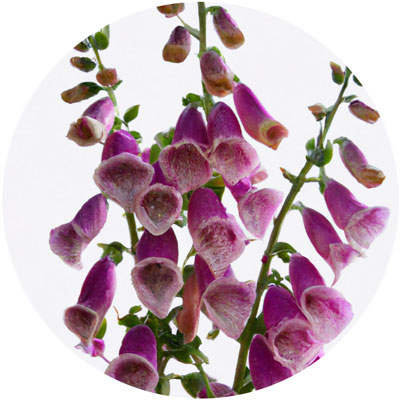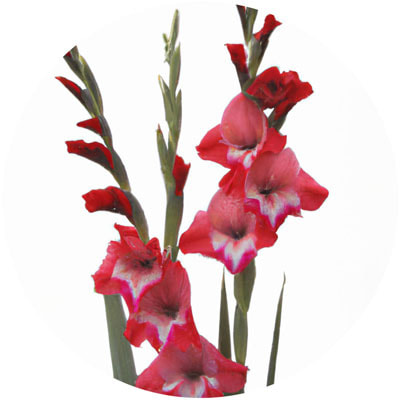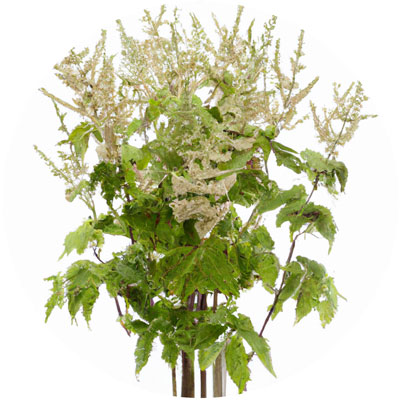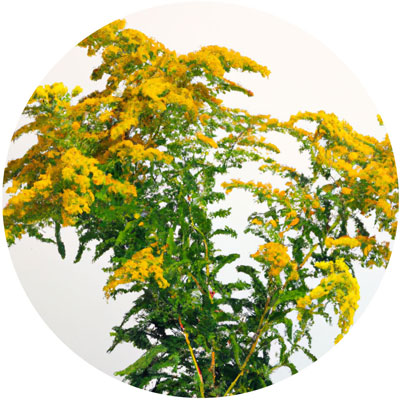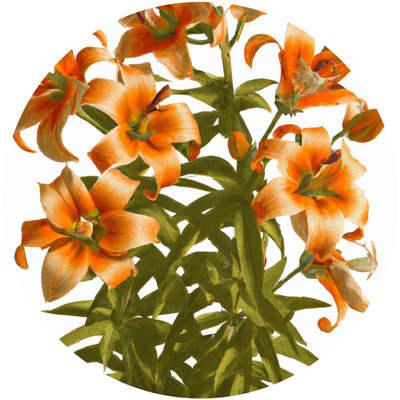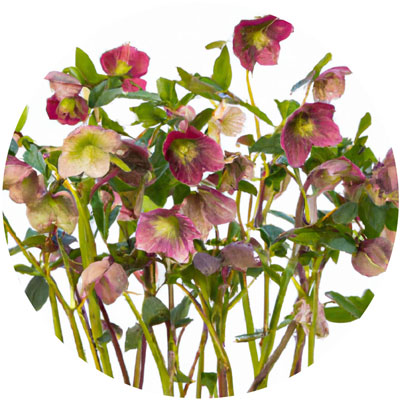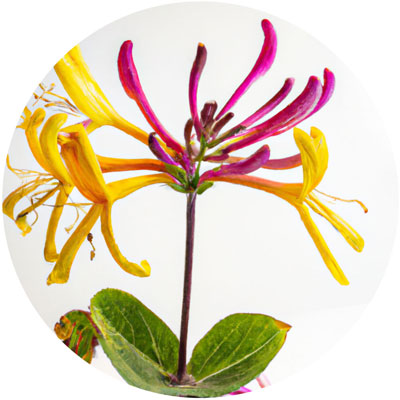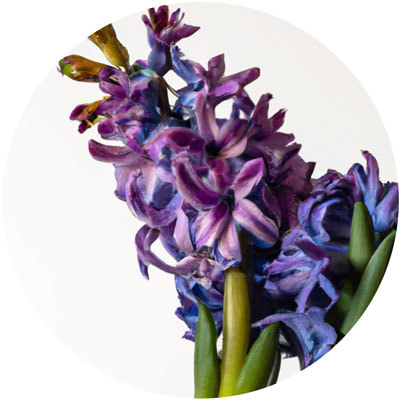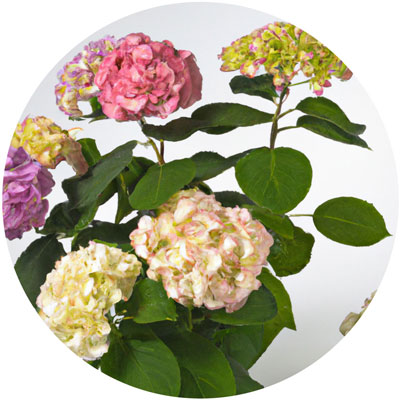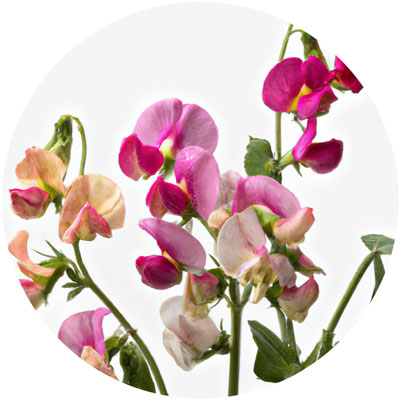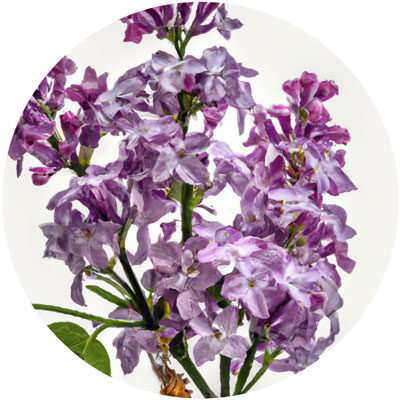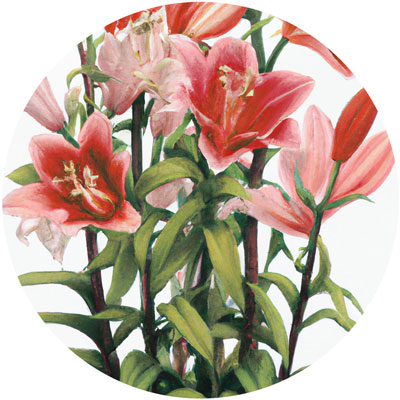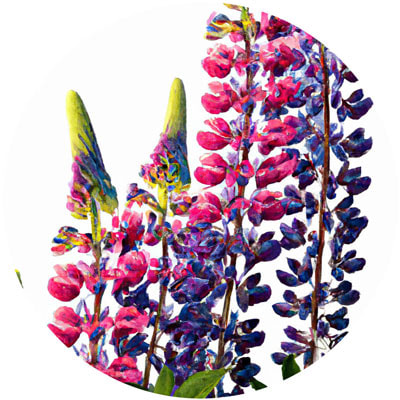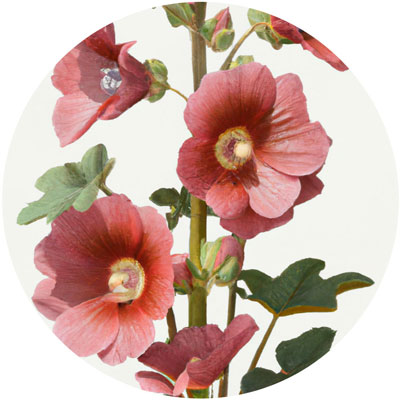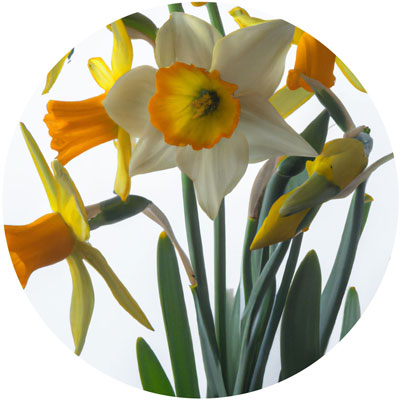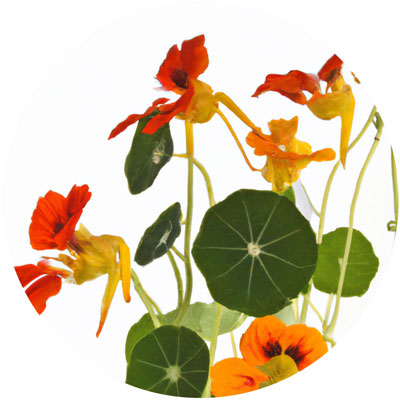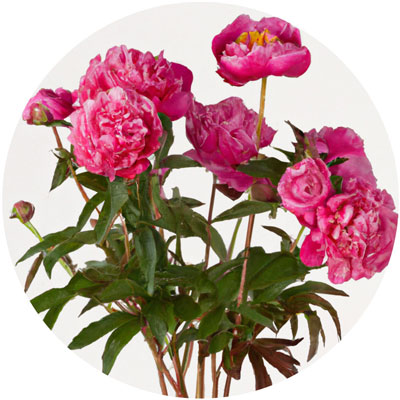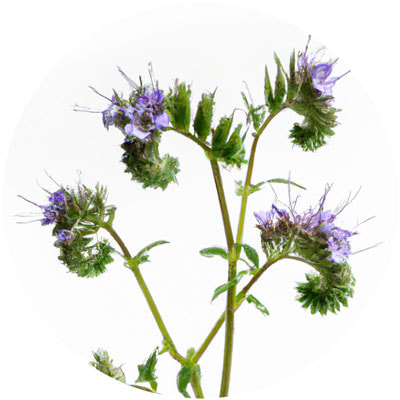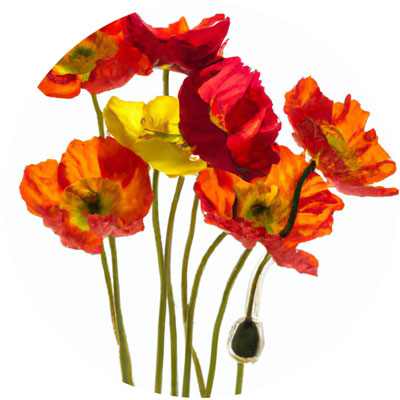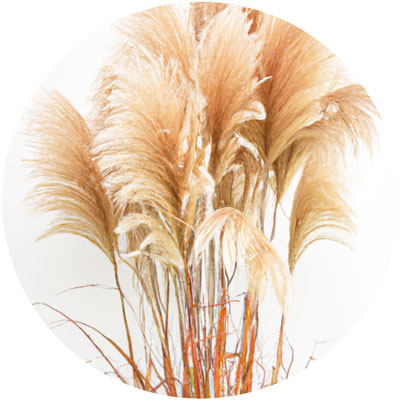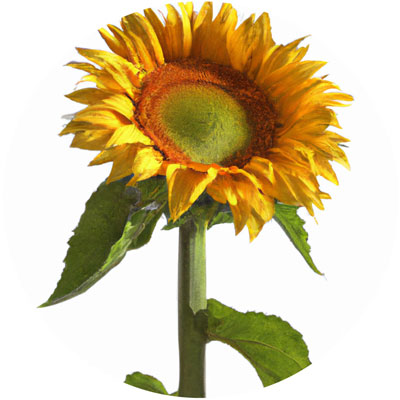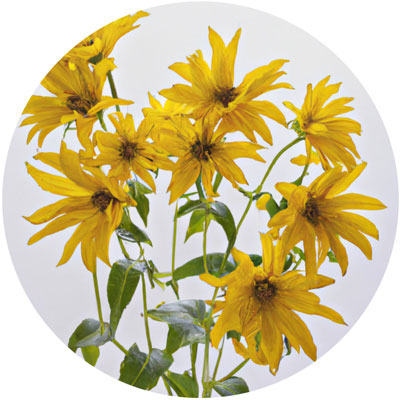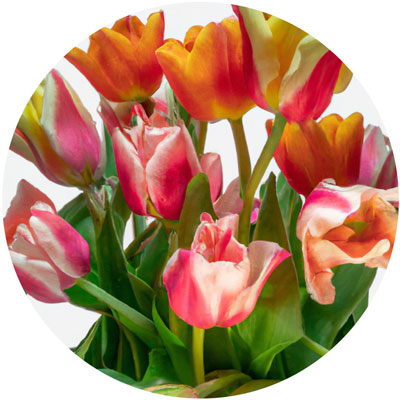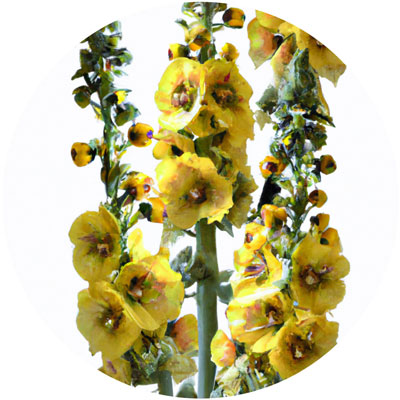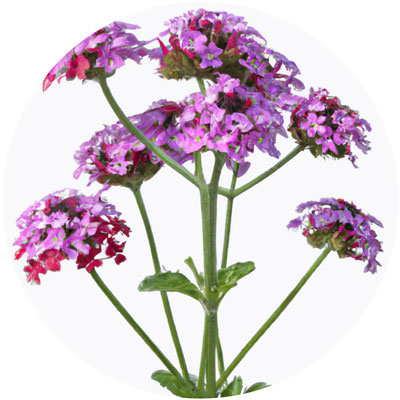Flowers & sustainability
|
Flowers brighten up the day and freshen up a room no matter the season:
Fresh tulips on a dreary winter day; lush peony in May, colorful foxgloves in high summer, and chrysanthemum and cosmea in the first weeks of fall.... Nature at its finest! But did you know the cut flower trade is actually not that great for nature at all? Check out this Ted.com article for the gruesome details. In a nutshell: flowers are flown thousands of miles in refrigerated airplanes, leading to a huge environmental footprint; The industrial cultivation of flowers often involves fertilizers and insecticides (pesticides) that run off into surrounding nature and are bad for human health; Creating controlled environments in greenhouses requires a lot of energy, and workers are not always treated properly. |
If you want to be able to enjoy a fresh bouquet without contributing to non-sustainable practices, there are a few things you can do:
1. If you have a garden: sow your own flowers and choose varieties that are native to your environment. - Added bonus is that it benefits the local bee- and insect populations. 2. Find an organic picking garden near you, and cut your own fresh seasonal flowers. or 3. Get your flowers from a local sustainable florist (E.G. in The Netherlands: Barometer Duurzame bloemist) And, no matter what you do: buy flowers that are in season. |
When flowers bloom...The Slow Flowers Movement: aimed to champion a more mindful, seasonal and sustainable consumption of cut flowers (source)
In layman's terms: No matter where you source your blooms, the most sustainable choice of cut-flower is always the flower that is locally in season at the time of picking/buying. To help you make an informed decision, we created an circular overview of seasonal flowers all through the year. (zoom in to read) Not a fan of the small letters on the screen? Download a PDF of the Year-round flower calendar here and print it out! (or download the black & white version and go easy on your cartridges) This Year-round Flower Calendar is created as an easy overview, a map, so to say. It visualizes the blooming season of most flowers native in temperate climate zones of Europe, the UK and a large portion of the United States (more about climate zones). Curious to learn more about the flowers on the calendar or would you like to know which flowers you can best buy during a certain month? Scroll on to find out more! NB Roses and orchids are notably absent on the calendar. As cut flowers they are either flown in with climate-controled airplanes, or grown in energy-guzzling heated greenhouses. (more here) |
Blooming flowers per month
Flowers A to Z
|
Agapanthus (July-August)
Agastache (June-October) Allium (April-July) Alstroemeria (June-July) Amaranthus (June-October) Anemone (April-May) Aquilegia (April-July) Astrantia (June-September) Bee Balm (June-July) Borage (June-July) Calendula (June-October) Campanula (June-August) Cardoon (August - September) Chamomile (June - October) |
Chrysanthemum (Sept-November)
Cornflower (June-August) Cosmea (July-October) Dahlia (July-October) Daisy (May-July) Delphinium (June-July) Echinacea (July-September) Foxglove (June-September) Guernsey Lily (Sept-November) Gladiolus (July-October) Goat's Beard (May-July) Goldenrod (August-September) |
Hellebore (February - April)
Hyacinth (March-April) Hydrangea (April-November) Honeysuckle (May-July) Lathyrus (June-September) Lilac (May) Lily (May-July) Love in a Mist (June-August) Lupine (May-July) Mallow (May-September) Narcissus (March-May) Nasturtium (June-October) |
Peony (May-June)
Phacelia (May-September) Poppy (June-July) Silver Grass (October-November) Sunflower (July-October) Topinambur (July-September) Tulip (October-May) Verbascum (June-September) Verbena (July-October) Viola (May-September) Wild Carrot (June-September) Wild Marjoram (July-September) Yarrow (June-September) |
Agapanthus (African Lily / Blue Lily)
Agapanthus, also known as African lily or blue lily, is a perennial flowering plant that produces large, showy blooms in shades of blue and purple.
It is a popular cut flower for bouquets and floral arrangements, and the vase-life of Agapanthus flowers is around 7-10 days. The plant has a long history of use in traditional South African medicine, where it was used to treat a variety of ailments including fever, headaches, and digestive problems. However, there is currently little scientific evidence to support these medicinal uses.
|
Agastache (Anise Hyssop)
Anise Hyssop (Agastache foeniculum) is a perennial flowering plant that produces spikes of colorful, tubular flowers in shades of blue, purple and white.
Anise Hyssop has a long history of use in traditional medicine, particularly in Native American medicine. The plant is believed to have medicinal properties that can help to relieve symptoms of cold and flu, as well as to promote digestion and relieve pain. Additionally, it has been used as a tea to calm nerves and relieve headaches. NB Anise Hyssop (Agastache) is not the same as Hyssop (Hyssopus). Anise Hyssop is Native to North America and a member of of the mint family, while Hyssop spp is a member of the carrot family and native to Europe. They are completely different genus and species!
|
Allium (decorative onion)
Alliums are known for their unique and striking flower heads, which can range in size from small, golf ball-sized clusters to large, soccer ball-sized clusters.
The flowers are composed of many small, star-shaped flowers that are tightly packed together, creating a spherical shape. They are typically purple, but can also be white, pink, or red. The flowers are usually arranged on top of tall, sturdy stems, and make a bold statement in any garden or floral arrangement. Allium are popular with bees and butterflies, and are great in naturalizing in meadows or woodlands.
|
Alstroemeria (Peruvian Lily)
Alstroemeria, also known as the Peruvian lily or lily of the Incas, is a popular cut flower that is known for its long vase life and vibrant colors.
The flowers are typically bell-shaped and come in a range of colors including white, pink, orange, red, and purple. The plant is can grow up to 3 feet tall. Native to South-America, the alstroemeria can be grown in temperate climates, but ask for a bit more care and protection against the worst winter frosts. As a herbacious perennial Alstroemeria die back each winter to resurface the next spring. They are attractive to bees and pollinating insects.
|
Amaranthus (Amaranth)
Amaranthus, also known as Amaranth, is a group of around 60 species of annual or short-lived perennial plants that are known for their striking, brightly colored flowers that come in shades of red, orange, yellow, and purple.
Amaranthus plants are typically tall, with green or red foliage and large, showy flowers. They are often used as a background or accent plant in gardens. In addition to their ornamental value, Amaranthus plants are also used for food and medicine in many cultures, and have been for thousands of years. In recent years, there has been increasing interest in using Amaranth as a food crop for the future due to its ability to tolerate extreme growing conditions, such as drought and poor soil. Additionally, Amaranth is a relatively quick-growing crop and is a good source of antioxidants, minerals and vitamins.
NB - Amaranthus MicrogreensAmaranthus microgreens can be grown from seed in 7 to 14 days and are high in vitamins and minerals, including vitamins A, C, and K, as well as iron and calcium.
They also contain antioxidants and have a slightly nutty, earthy flavor. |
Anemone (Windflowers)
Anemone is a genus of around 120 species of perennial plants that are known for their beautiful, delicate flowers that come in a wide range of colors, including white, pink, red, purple, and blue.
The flowers are often used in cut flower arrangements, bouquets, and wreaths, and are often associated with the arrival of spring. Native to the temperate and subtropical regions of the world, these plants are known for their hardiness and easy-care nature, making them a popular choice for gardeners. In traditional medicine, anemone roots have been used to treat various ailments such as headaches, fevers, and inflammatory conditions.
|
Aquilegia (columbine / granny's bonnet)
Aquilegia, also known as columbine or granny's bonnet, is a genus of around 70-75 species of perennial plants that are are known for their unique, brightly colored flowers that come in a wide range of colors, including red, pink, purple, yellow, and blue.
The flowers are often used in cut flower arrangements, bouquets, and wreaths, and are often associated with early summer. Native to the temperate and subtropical regions of the Northern Hemisphere, these plants are known for their hardiness and easy-care nature, making them a popular choice for gardeners.
|
Astrantia (masterwort)
Astrantia, also known as masterwort, is a genus of around 6-8 species of perennial plants that are known for their unique, star-shaped flowers that come in a range of colors including white, pink, red and purple, and are often used in cut flower arrangements and bouquets.
Native to Europe, Asia and Northern Africa, Astrantia is also a popular garden perennial and can be used in borders, and woodland gardens.
|
Bee Balm (Monarda didyma)
Bee Balm (Monarda didyma) is a perennial flowering plant native to North America. It produces spikes of colorful, tubular flowers in shades of red, pink, purple and white, and is a popular cut flower for bouquets and floral arrangements.
Bee Balm has a long history of use in traditional medicine, particularly in Native American medicine. The plant is believed to have medicinal properties that can help to relieve symptoms of colds, flu, and other respiratory infections. Additionally, it has been used as a tea to calm nerves and relieve headaches. Bee Balm is also used as a natural remedy for digestive issues and skin conditions such as eczema.
|
Borage (Borago Officinalis / Starflower)
Borage (Borago officinalis) is an annual flowering plant native to the Mediterranean region. It produces blue, star-shaped flowers and hairy leaves and is a popular cut flower for bouquets and floral arrangements.
Borage has a long history of use in traditional medicine, particularly in Europe and Middle East. The plant is believed to have medicinal properties that can help to relieve symptoms of anxiety and depression, as well as to promote healthy skin and hair. Additionally, it has been used as a diuretic, anti-inflammatory and to reduce fever.
|
Calendula (pot marigold)
Calendula is a popular cut flower known for its vibrant orange and yellow hues. These flowers are native to the Mediterranean region and have been used for centuries in traditional medicine and as a culinary herb.
Calendula is best known for its medicinal properties. The petals of the flower contain compounds that have anti-inflammatory and antimicrobial effects. Calendula has been used to treat a wide range of skin conditions, including eczema, rashes, and minor cuts and scrapes. Additionally, it is also known to have wound healing properties. In cooking, the petals are often used to add color and flavor to salads, soups, and other dishes. The petals are also used to make a yellow dye for fabrics and food. The flowers can easily be dried.
|
Campanula (bellflower)
Campanula is a genus of flowering plants that includes several species commonly known as bellflowers. These plants are prized for their beautiful, bell-shaped flowers that come in a variety of colors, including blue, purple, white, and pink.
|
Cardoon (artichoke thistle)
Cardoon, also known as the artichoke thistle, is a perennial plant that is closely related to the artichoke. It is native to the Mediterranean region and has been cultivated for centuries for its edible stems and leaves.
Cardoon has a rich history of cultivation dating back to ancient Greece and Rome. It was used medicinally for a variety of ailments, including digestive disorders and kidney problems. The plant has also been used as a source of food and medicine in traditional cultures throughout the Mediterranean region. NB. Are known to dry well if you prefer dried flowers.
|
Chamomile (Chamaemelum Nobile)
Chamomile (Matricaria chamomilla or Chamaemelum nobile) is a perennial or annual flowering plant that produces small, daisy-like flowers. It is commonly used as a cut flower for bouquets and floral arrangements and is known for its soothing fragrance.
Chamomile has a long history of use in traditional medicine, particularly in Europe and Middle East. The plant is believed to have medicinal properties that can help to relieve symptoms of anxiety and depression, as well as to promote healthy skin and hair. Additionally, it has been used as a natural remedy for insomnia, indigestion, and as a mild sedative. Chamomile tea is commonly used as a natural remedy for stomach ache and menstrual cramps.
|
Chrysanthemum (mum/chrysanth)
Chrysanthemums, also known as mums or chrysanths, are a genus of flowering plants that are native to Asia and northeastern Europe. They are prized for their large, brightly colored flowers that come in a variety of shapes and sizes.
Chrysanthemums have a rich history in many cultures, particularly in Asia, where they have been cultivated for thousands of years. The Chinese have used chrysanthemums for medicinal purposes and as an important symbol in art and literature. Chrysanthemums symbolize longevity and rejuvenation in Chinese culture. Depending on the cultivar, chrysanthemums have been known to last in a vase for up to 3 weeks. Are known to dry well for a dried flower bouquet.
|
Cornflower (centaurea cyanus)
Cornflower, also known as Centaurea cyanus, is an annual flowering plant that is native to Europe. It is prized for its beautiful, blue, and sometimes pink or white flowers.
Although the flowers have a relatively short vase-life, they are known to dry well if you prefer dried flowers. Cornflower has a rich history of cultivation, it was traditionally grown as a crop in the past, being used as a flour supplement or as a dye. It was also used in traditional medicine, being considered as a remedy for eye problems, skin conditions and as a wound healer.
|
Cosmea (Garden Cosmos/Mexican aster)
Cosmea / Cosmos bipinnatus, also known as the Garden Cosmos, is an annual flowering plant that is prized for its large, daisy-like flowers that come in a variety of colors, including pink, red, white and yellow.
The plant is often used as a cut flower or in wildflower gardens and is known to dry well if you prefer dried flowers.
|
Dahlia
Dahlia is a genus of perennial flowering plants that are prized for their large, brightly colored flowers that come in a wide variety of shapes and sizes, from small pom-pom to large dinner plate size.
They are popularly used for cut flowers, dried flowers, and as potted plants. Dahlias have a rich history of cultivation, they have been cultivated by the Aztecs for many centuries, before being brought to Europe in the 18th century. They have been traditionally used as a source of food, medicine and as a decorative plant.
|
Daisy
Daisy is a common name for a number of different species of flowering plants in the family Asteraceae, many of which are popularly used as cut flowers. These plants are known for their brightly colored flowers that have a central disk surrounded by white or brightly colored petals.
Daisies have a rich history of cultivation and have been used for medicinal purposes for centuries. They were used in traditional medicine to treat a variety of ailments such as skin disorders, fever and to ease inflammation.
|
Delphinium (larkspur)
Delphinium, also known as larkspur, is a genus of perennial flowering plants that are native to Europe and Asia.
They are prized for their tall spikes of brightly colored flowers that come in shades of blue, purple, white, and pink. They are popularly used for cut flowers and as garden plants. Delphinium has a rich history of cultivation, it was traditionally used as a medicinal plant to treat a variety of ailments such as skin disorders, fever and to ease inflammation. The plant also has a rich cultural significance and has been used in literature, art, and mythology.
|
Echinacea (coneflower)
Echinacea, also known as the coneflower, is a genus of perennial flowering plants that are native to North America. They are prized for their large, daisy-like flowers with a central cone-shaped disk that come in shades of pink, purple, orange and yellow and are popularly used for cut flowers, dried flowers, and as garden plants.
Echinacea has a long history of traditional medicinal use by Native Americans, it was used to treat a wide range of conditions, from snakebites to headaches. Today, it is widely used as a dietary supplement to boost the immune system and to treat colds and flu.
|
Foxglove (digitalis purpurea)
Foxglove, also known as Digitalis purpurea, is a biennial or perennial flowering plant that is native to Europe. It is prized for its tall spikes of bell-shaped flowers that come in shades of pink, purple, white, and yellow. They are popularly used for cut flowers and as garden plants and are known to dry well if you prefer dried flowers.
Foxglove has a long history of medicinal use, it was traditionally used to treat heart conditions and still is used today as a source of digitalis, a drug that is used to treat heart failure and other heart conditions. It is important to note that all parts of the plant are highly toxic and should not be ingested, the sap can cause skin irritation, and the leaves and seeds should not be consumed.
|
Gladiolus (sword lily)
Gladiolus (Gladiolus spp.) is a perennial flowering plant that produces tall spikes of large, trumpet-shaped flowers in a variety of colors, including red, pink, orange, yellow, and white. It is commonly used as a cut flower for bouquets and floral arrangements, and the vase-life of Gladiolus flowers is around 7-10 days, depending on the freshness of the cut stems and the quality of the water they are placed in.
Gladiolus has a long history of use in traditional medicine, particularly in Africa and Asia. It is believed to have medicinal properties that can help to relieve symptoms of various ailments such as wounds, respiratory issues, and skin conditions.
|
Goat's Beard (Aruncus dioicus)
Goat's beard (Aruncus dioicus) is a perennial flowering plant that produces tall spikes of feathery, white flowers. It is commonly used as a cut flower for bouquets and floral arrangements.
Goat's beard has a long history of use in traditional medicine, particularly in Europe and Asia. It is believed to have medicinal properties that can help to relieve symptoms of various ailments such as skin conditions, wound healing, and as a diuretic.
|
Goldenrod (Solidago Spp.)
Goldenrod (Solidago spp.) is a perennial flowering plant that produces clusters of small, yellow flowers. It is commonly used as a cut flower for bouquets and floral arrangements.
Goldenrod has a long history of use in traditional medicine, particularly in North America. It is believed to have medicinal properties that can help to relieve symptoms of various ailments such as respiratory issues, skin conditions, and as a diuretic.
|
Guernsey Lily (Nerine Sarniensis)
Guernsey lily, also known as Nerine sarniensis, is a perennial bulbous flowering plant that is prized for their large, brightly colored flowers that come in shades of pink, red, white and orange.
They are popularly used as cut flowers and as garden plants and are known to dry well if you prefer dried flowers.
|
Hellebore (Helleborus)
Hellebore, also known as Helleborus, is a genus of perennial flowering plants that are native to Europe and Asia. They are prized for their large, cup-shaped flowers that come in shades of white, pink, green, and purple. They are popularly used as cut flowers and as garden plants.
Hellebore has a long history of medicinal use, it was traditionally used to treat a variety of ailments such as skin disorders, fever and to ease inflammation. However, all parts of the plant are highly toxic and should not be ingested.
|
Honeysuckle (Lonicera Spp.)
Honeysuckle (Lonicera spp.) is a perennial flowering plant that produces clusters of small, trumpet-shaped flowers in colors of red, orange, yellow, pink and white.
It is commonly used as a cut flower for bouquets and floral arrangements and blooms in late spring to early summer. Honeysuckle has a long history of use in traditional medicine, particularly in Asia. It is believed to have medicinal properties that can help to relieve symptoms of various ailments such as respiratory issues, skin conditions, and as a diuretic. Additionally, it has been used as a natural remedy for fever and sore throat.
|
Hyacinth (hyacinthus)
Hyacinth, also known as Hyacinthus, is a genus of perennial bulbous flowering plants that are are prized for their large, fragrant, clusters of bell-shaped flowers that come in shades of pink, red, white, blue, purple, and yellow. They are popularly used as cut flowers, indoor plants and as garden plants.
Hyacinth has a rich history and cultural significance, it was sacred to the ancient Greeks and Romans, and it has been used in literature, art, and mythology.
|
Hydrangea
Hydrangea, is a genus of flowering plants that are prized for their large, showy clusters of flowers that come in shades of pink, blue, purple, and white. They are popularly used as cut flowers and as garden plants.
Hydrangea has a rich history and cultural significance, it has been used in literature, art, and as a symbol of gratitude, understanding, and apology.
|
Lathyrus (Sweet pea)
Lathyrus, also known as sweet pea, is a popular cut flower known for its fragrant and brightly colored blooms.
The vase life of sweet peas is relatively short, typically lasting only a few days. Sweet peas have a rich history, with the first recorded cultivation dating back to the 17th century in Italy. They were later brought to England, where they quickly became popular in gardens and as cut flowers. In the early 20th century, a breeding program was established in England, resulting in the development of the many cultivars we know today. There is some evidence to suggest that sweet peas may have medicinal properties. The seeds of certain species have been traditionally used to treat conditions such as high blood pressure and anxiety. However, more research is needed to fully understand the potential health benefits of sweet peas.
|
Lilac (Syringa)
Lilacs, also known as Syringa, are a popular cut flower known for their fragrant and colorful blooms. The vase life can vary depending on the cultivar and the stage of maturity at which they are cut.
Lilacs have a rich history, with the first recorded cultivation dating back to ancient Greece and Rome. They were later brought to Europe, where they quickly became popular in gardens and as cut flowers. In the late 19th century, a breeding program was established in France, resulting in the development of many new cultivars. There is some evidence to suggest that lilacs may have medicinal properties. The flowers and leaves have been traditionally used to treat conditions such as fever, sore throat, and skin irritation. However, more research is needed to fully understand the potential health benefits of lilacs.
|
Lily
Lilies are a popular cut flower known for their large, fragrant and colorful blooms. The vase life of lilies can vary depending on the cultivar and the stage of maturity at which they are cut.
Lilies have a rich history, with the first recorded cultivation dating back to ancient civilizations such as China and Egypt. They have been used for medicinal purposes, as well as for religious and cultural celebrations. In the 19th century, breeding programs have been established to create new cultivars with different colors, sizes and shapes. There is some evidence to suggest that lilies may have medicinal properties. The bulbs of certain species have been traditionally used to treat conditions such as fever and skin irritation.
|
Love in a Mist (Nigella Damascena)
Love-in-a-mist (Nigella damascena) is an annual flowering plant that produces delicate, blue, pink, or white flowers surrounded by feathery foliage. It is commonly used as a cut flower for bouquets and floral arrangements, and the blooming months for Love-in-a-mist are typically in late spring to early summer.
Love-in-a-mist does not have a significant history of use in traditional medicine. However, its seeds (Nigella Seeds) were traditionally used in Middle East and Asia to make a condiment and a spice, and it is also used in some traditional medicine systems.
|
Lupine (Lupinus)
Lupine, also known as Lupinus, is a popular cut flower known for its tall spikes of colorful and fragrant blooms. The vase life of lupines is relatively short, typically lasting only a few days.
Lupines have a rich history, with the first recorded cultivation dating back to ancient civilizations such as Greece and Rome. They have been used for medicinal purposes, as well as for animal feed and ornamental gardening. In the 19th century, breeding programs have been established in Europe and North America to create new cultivars with different colors, sizes and shapes. There is some evidence to suggest that lupines may have medicinal properties. The seeds, leaves and root of certain species have been traditionally used to treat conditions such as diabetes, high blood pressure, and skin irritation.
|
Mallow (Malva)
Mallow, also known as Malva, is a popular cut flower known for its large, round, and colorful blooms. The vase life of mallow is relatively short, typically lasting only a few days.
Mallow has a rich history, with the first recorded cultivation dating back to ancient civilizations such as Greece and Rome. The plant has been used for medicinal purposes, as well as for ornamental gardening. The leaves, flowers, and roots have been traditionally used to treat conditions such as sore throat, cough, and skin irritation.
|
Narcissus (Daffodil)
Narcissus, also known as daffodil, is a popular cut flower known for its brightly colored and fragrant blooms. The vase life of narcissus can vary depending on the cultivar and the stage of maturity at which they are cut, but generally ranges from 7-14 days.
Narcissus has a rich history, with the first recorded cultivation dating back to ancient civilizations such as Greece and Rome. They were later brought to Europe, where they quickly became popular in gardens and as cut flowers. In the 19th century, breeding programs were established, resulting in the development of many new cultivars. There is some evidence to suggest that Narcissus may have medicinal properties, the bulb of certain species have been traditionally used to treat conditions such as fever and skin irritation.
|
Nasturtium (Tropaeolum majus)
Nasturtium (Tropaeolum majus) is an annual flowering plant that produces large, brightly colored flowers in shades of orange, red, yellow and cream. It is commonly used as a cut flower for bouquets and floral arrangements and blooms from late spring to early fall.
Nasturtium has a long history of use in traditional medicine, particularly in South America. The plant is believed to have medicinal properties that can help to relieve symptoms of various ailments such as respiratory issues, skin conditions, and as a natural remedy for fever and sore throat. Additionally, the seeds and leaves are high in vitamin C and have been used as a tonic to prevent scurvy.
|
Peony (Peaonia)
Peony, also known as Paeonia, is a popular cut flower known for its large, fragrant, and colorful blooms. The vase life of peonies can vary depending on the cultivar and the stage of maturity at which they are cut, but generally ranges from 5-10 days.
Peonies have a rich history, with the first recorded cultivation dating back to ancient civilizations such as Greece and China. They have been used for medicinal purposes and as ornamental plants. They have also been used in traditional Chinese medicine for centuries to treat conditions such as anxiety and insomnia.
|
Phacelia (Scorpion Weed)
Phacelia, also known as Phacelia tanacetifolia, is a popular cut flower known for its clusters of delicate and colorful blooms. The vase life of phacelia is relatively short, typically lasting only a few days.
Phacelia has a relatively short history of cultivation, it was first introduced as a cover crop and for ornamental purposes in the 20th century in North America. Phacelia tanacetifolia has been known to have beneficial effects on soil health, it is often used as a cover crop for its ability to fix nitrogen and improve soil structure. There is limited evidence to suggest that Phacelia may have medicinal properties, the plant has been traditionally used to treat conditions such as respiratory issues and skin irritation.
|
Poppy (Papaver Rhoeas / Corn Poppy)
Papaver rhoeas, also known as the common poppy or corn poppy, is a species of poppy known for its bright red, cup-shaped flowers. It is commonly used as a cut flower for bouquets and floral arrangements. The blooming months for Papaver rhoeas are typically in late spring to early summer, depending on the climate.
Burning the ends of poppy stems before arranging them is a technique known as "singeing" or "cauterizing" that can help to prolong the life of the flowers. The process of singeing involves quickly passing the stem ends through a flame, such as a candle or a lighter, to seal off the end of the stem. This keeps the quick-to-seep poppy sap from exiting the flower from the bottom, which then helps the flower retain its own moisture (and vital nutrients) and be able to drink water from the vase for longer. Papaver rhoeas has a long history of use in traditional medicine, particularly in Europe. The plant is believed to have medicinal properties that can help to relieve symptoms of various ailments such as respiratory issues, skin conditions, and as a natural remedy for fever and sore throat. Additionally, the seeds have been used as a sedative and the latex has been used as a painkiller.
|
Silver Grass (Miscanthus)
Silver grass, also known as Miscanthus, is a popular cut flower known for its tall, feathery, and silvery blooms. The vase life of silver grass can vary depending on the cultivar and the stage of maturity at which they are cut, but generally ranges from 7-14 days.
Silver grass has a rich history, with the first recorded cultivation dating back to ancient civilizations in Asia. It has been used for decorative and ornamental purposes, as well as for traditional medicine. In the 19th century, breeding programs were established, resulting in the development of many new cultivars. There is limited evidence to suggest that silver grass may have medicinal properties. The plant has been traditionally used to treat conditions such as fever, sore throat, and skin irritation.
|
Sunflower (Heliantus Annuus)
The sunflower, scientifically known as Helianthus annuus, is a tall, annual plant that is native to North America.
The sunflower has a long history of cultivation by indigenous peoples in North America, and was later adopted by European settlers. The plant was used for a variety of purposes, including as a source of food, medicine, and oil. In terms of medicinal properties, sunflower oil has been found to be high in antioxidants and may have anti-inflammatory properties. Some studies have also suggested that sunflower seeds may have anti-cancer properties.
NB- Sunflower microgreensSunflower microgreens are the young, edible shoots of the sunflower plant. They are typically harvested when the plant is about 6-8 cm (2-3 inches) tall and are considered to be a type of sprout.
Sunflower microgreens are a good source of vitamins and minerals, including Vitamin A, Vitamin C, Vitamin E, and B vitamins. They are also high in antioxidants and have been found to have anti-inflammatory properties. Sunflower microgreens have a mild, nutty flavor and can be eaten raw or cooked. They can be added to salads, sandwiches, or used as a garnish. They are also commonly used as a garnish for soups, sandwiches, and sushi. |
Topinambur (Jerusalem artichoke)
Topinambur, also known as Jerusalem artichoke, is a perennial flower that belongs to the sunflower family. It is known for its large, yellow, daisy-like flowers that bloom from July to September.
The plant has a long history of cultivation, with evidence of it being grown by Native Americans for both food and medicinal purposes. It is now commonly grown as a vegetable crop for its edible tubers, which can be eaten raw or cooked. The tubers are a good source of dietary fiber, potassium, and iron. In addition to its edible uses, topinambur has been traditionally used for medicinal purposes. The plant is believed to have anti-inflammatory and anti-diabetic properties.
|
Tulip
Tulip is a popular cut flower known for its brightly colored and fragrant blooms. The vase life of tulips can vary depending on the cultivar and the stage of maturity at which they are cut, but generally ranges from 7-14 days.
Tulips have a rich history, with the first recorded cultivation dating back to ancient civilizations in the Middle East. They were later brought to Europe, where they quickly became popular in gardens and as cut flowers. In the 16th century, the Netherlands became the center of tulip cultivation and breeding, resulting in the development of many new cultivars. There is limited evidence to suggest that tulips may have medicinal properties. The bulbs of certain species have been traditionally used to treat conditions such as fever, sore throat, and skin irritation.
|
Verbascum (Mullein)
Verbascum, also known as mullein, is a popular cut flower known for its tall spikes of large, colorful, and fragrant blooms. The vase life of verbascum can vary depending on the cultivar and the stage of maturity at which they are cut, but generally ranges from 5-7 days.
Verbascum has a rich history, with the first recorded cultivation dating back to ancient civilizations such as Greece and Rome. They have been used for medicinal purposes and as ornamental plants. The leaves, flowers, and roots of the plant have been traditionally used to treat a variety of ailments, such as sore throat, cough, and skin irritation.
|
Verbena (Vervain)
Verbena, also known as Vervain, is a popular cut flower known for its clusters of delicate, colorful and fragrant blooms. The vase life of verbena is relatively short, typically lasting only a few days.
Verbena has a rich history, it is believed that ancient civilizations in Europe, Africa, and America used the plant for medicinal and ceremonial purposes. Verbena has been used as a treatment for various conditions such as anxiety, insomnia, and skin irritation.
|
Viola (Pansy)
Pansies or Viola are known for their vibrant colors and cheerful faces, which resemble a human face.
They are available in a wide range of colors including, purple, yellow, red, blue, and white. One Viola variety is the Violet, which is always a blueish purple. Pansies typically bloom from spring to fall, with peak blooming time in the spring. Pansies have a long history of cultivation and have been popular garden flowers for centuries. They were first cultivated in the Middle Ages, and have been used in traditional medicine to treat a variety of ailments such as sore throat, cough, and fever.
|
Wild Carrot (Daucus Carota / Bishop's Lace)
Wild carrot, also known as Daucus carota, is a popular cut flower known for its delicate, lacy, and white blooms. The vase life of wild carrot is relatively short, typically lasting only a few days.
Wild carrot has a rich history, it has been known to be used as a medicinal plant since ancient times. The ancient Greeks and Romans used wild carrot to treat a variety of ailments, such as digestive issues, skin irritation, and respiratory infections. It was also used to ward off evil spirits.
|
Wild Marjoram (Origanum Vulgare)
Wild Marjoram, also known as Origanum vulgare, is a perennial herb that belongs to the mint family. It is native to Europe and Asia, but can now be found in many parts of the world.
The plant produces small, pink or purple flowers that bloom between June and August and have a long vase life of up to two weeks. In history, Wild Marjoram was used medicinally by the ancient Greeks and Romans to treat a variety of ailments. The plant is still used today to make teas and infusions that are believed to help with digestion, respiratory problems, and menstrual cramps.
|
Yarrow (Achillea Millefolium)
Yarrow, also known as Achillea millefolium, is a perennial herb native to Europe and Asia. The flowers have a unique, feathery appearance and come in a variety of colors, including white, pink, and yellow.
In terms of vase life, yarrow has a long lasting vase life of up to 2 weeks. Yarrow has a rich history and has been used for centuries as a medicinal herb, and its dried leaves and flowers were traditionally used to treat wounds and stop bleeding. The ancient Greeks named it for Achilles, the hero of the Trojan War, because they believed it had healing properties for wounds. It was also used in traditional Chinese medicine and by Native Americans for various medicinal purposes.
|

